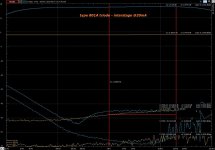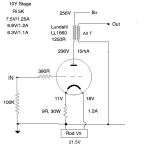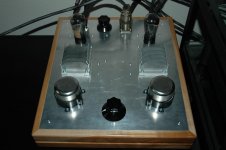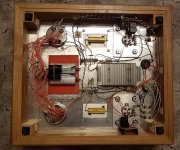I’ve been reading through this entire thread over the past few weeks and I’m now convinced I need to try a DHT linestage 🙂. This thread has been very informative with lots of good ideas. Thanks to all the contributors. I’m hoping there are still some folks still following to give me some ideas.
I had originally planned on using the type 26, but as I got further into this thread, I’m thinking that a 01a or 10y/801a might make more sense.
I’ve built a few tube amplifiers and preamps over the past few years, as well as several SS amps and preamps, so I have some confidence in my building skills.
My requirements are slightly unusual because of my speaker system. I use separate amplifiers with servo-control for my woofer towers and use single-ended connections to these amps. My main line-array speakers operate from about 150Hz on up and all my amps that I use on these use balanced inputs.
So, I’m planning a line stage which will use an input transformer to convert balanced inputs to single-ended, feeding a relay stepped-attenuator with an input impedance of 100K. The output of the attenuator will feed the DHT stage for my main speakers, as well as a separate discrete FET-input line amplifier with single-ended output for my woofer towers.
I want to use an output transformer on the DHT stage to generate a balanced output for my main amplifiers. I suppose this could be a parafeed OT, but I think it makes more sense to use a step-down transformer as the anode load.
My current DAC is a Terminator Plus with a max output of 4.4V RMS and 1250 ohm impedance, so I don’t need a lot of gain. I’m planning to use a LL1676 as the input transformer which has a 1:2 connection option if I need a little more gain.
I use long (7m) balanced interconnects to my amps, which have input impedances ranging from 24K to 100K. My cables are Iconoclast 4x4 OCC which have a capacitance of about 18pf/ft, so figure about 400pf from the cables.
I’m planning a two chassis implementation, with power transformers, rectifiers, chokes and caps in the PS chassis, and Salas SSHV2 and Rod Coleman’s filament regs in the amp chassis.
So, the question is what tube and OT combination would you all recommend to get the best performance from 150Hz up (I don’t want terrible low bass performance in case I want to repurpose this preamp, but this isn’t a priority). I was planning on filament bias if I go with the 26, but not sure if this is the best option with another tube. Cost is not a huge factor, although I don’t think I am ready to spring for silver transformers at this point.
I'd appreciate any input. Thanks.
I had originally planned on using the type 26, but as I got further into this thread, I’m thinking that a 01a or 10y/801a might make more sense.
I’ve built a few tube amplifiers and preamps over the past few years, as well as several SS amps and preamps, so I have some confidence in my building skills.
My requirements are slightly unusual because of my speaker system. I use separate amplifiers with servo-control for my woofer towers and use single-ended connections to these amps. My main line-array speakers operate from about 150Hz on up and all my amps that I use on these use balanced inputs.
So, I’m planning a line stage which will use an input transformer to convert balanced inputs to single-ended, feeding a relay stepped-attenuator with an input impedance of 100K. The output of the attenuator will feed the DHT stage for my main speakers, as well as a separate discrete FET-input line amplifier with single-ended output for my woofer towers.
I want to use an output transformer on the DHT stage to generate a balanced output for my main amplifiers. I suppose this could be a parafeed OT, but I think it makes more sense to use a step-down transformer as the anode load.
My current DAC is a Terminator Plus with a max output of 4.4V RMS and 1250 ohm impedance, so I don’t need a lot of gain. I’m planning to use a LL1676 as the input transformer which has a 1:2 connection option if I need a little more gain.
I use long (7m) balanced interconnects to my amps, which have input impedances ranging from 24K to 100K. My cables are Iconoclast 4x4 OCC which have a capacitance of about 18pf/ft, so figure about 400pf from the cables.
I’m planning a two chassis implementation, with power transformers, rectifiers, chokes and caps in the PS chassis, and Salas SSHV2 and Rod Coleman’s filament regs in the amp chassis.
So, the question is what tube and OT combination would you all recommend to get the best performance from 150Hz up (I don’t want terrible low bass performance in case I want to repurpose this preamp, but this isn’t a priority). I was planning on filament bias if I go with the 26, but not sure if this is the best option with another tube. Cost is not a huge factor, although I don’t think I am ready to spring for silver transformers at this point.
I'd appreciate any input. Thanks.
Depending on budget I would recommend considering the EML20B, and amorphous core output transformers. Before I went all digital (AES and balanced audio to amps) I used a line stage with LL1948 transformers for balanced inputs, a bunch of RCA inputs, TKD stepped attenuators, fixed bias 20B and 20K:600/150R custom Monolith Magnetics output transformers.
Consider shock mounting whatever DHT you use, and despite the cool factor shielding the tubes is sort of important if you want quiet.
The system was 3 way active at the time with electronic crossovers with balanced I/O all amps with balanced inputs and input transformers.
The 26 is pretty microphonic as was the 01A. I ultimately ended up with 112/12 type triodes which had lower rp and worked even better with the HA-133 transformers than the 26 did.
I still use the 20B line stage in another system..
I am surprised you are running the LF on unbalanced signal lines, I run subs (with balanced inputs) and a mix of class A dht and class D amps.. I like the lack of ground loops. My system is highish efficiency with Onken bass bins, Yuichi A-290 clones with TAD-4001 and FaitalPro HF10AK on STH100 horns. Very noise conscious.
I look forward to hearing more about your project.
Consider shock mounting whatever DHT you use, and despite the cool factor shielding the tubes is sort of important if you want quiet.
The system was 3 way active at the time with electronic crossovers with balanced I/O all amps with balanced inputs and input transformers.
The 26 is pretty microphonic as was the 01A. I ultimately ended up with 112/12 type triodes which had lower rp and worked even better with the HA-133 transformers than the 26 did.
I still use the 20B line stage in another system..
I am surprised you are running the LF on unbalanced signal lines, I run subs (with balanced inputs) and a mix of class A dht and class D amps.. I like the lack of ground loops. My system is highish efficiency with Onken bass bins, Yuichi A-290 clones with TAD-4001 and FaitalPro HF10AK on STH100 horns. Very noise conscious.
I look forward to hearing more about your project.
The plate resistance of the tube dictates the specs of the output xfmr, here are the values for some popular DHT triodes; type 26-7k, 10Y/801A-5k, EML20B-3k... multiply this value by 4 and you'll find the minimal primary impedance of the output xfmr. I've built interstage xfmrs (not output) for all of them and I can say the specs of the xfmrs vary wildly...
The 2 chassis setup is definitely a good idea 🙂
The 2 chassis setup is definitely a good idea 🙂
Yeah, no good output transformers are available for 10Y either off the shelf or custom wound. It's likely the best sounding tube of them all but you should really use something like a gyrator load to get optimal results.
I've been building with DHTs for 15 years and my rank order would be:
10Y
26
112A
I haven't put 01A in there because it needs a gyrator and I prefer to use a resistor load or an OPT. The 10Y is preferred because it's the best overall and for low level detail. The 26 is lovely on voices but a little fuller sounding. The 112A is some way behind both. So I'd use the 10Y without question. I've used filament bias in the past but it requires more voltage and big heatsinks and cathode resistors. So these days I feed the filaments in the normal way with Rod Coleman V9 regs. I made an OPT out version this year which turned out very well, using the LL1660 in step-down Alt T, and that would be what I'd recommend. Here's the schematic for SE out but you could leave the secondaries floating.
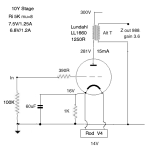
10Y
26
112A
I haven't put 01A in there because it needs a gyrator and I prefer to use a resistor load or an OPT. The 10Y is preferred because it's the best overall and for low level detail. The 26 is lovely on voices but a little fuller sounding. The 112A is some way behind both. So I'd use the 10Y without question. I've used filament bias in the past but it requires more voltage and big heatsinks and cathode resistors. So these days I feed the filaments in the normal way with Rod Coleman V9 regs. I made an OPT out version this year which turned out very well, using the LL1660 in step-down Alt T, and that would be what I'd recommend. Here's the schematic for SE out but you could leave the secondaries floating.

So, I’m planning a line stage which will use an input transformer to convert balanced inputs to single-ended, feeding a relay stepped-attenuator with an input impedance of 100K. The output of the attenuator will feed the DHT stage for my main speakers, as well as a separate discrete FET-input line amplifier with single-ended output for my woofer towers.
I want to use an output transformer on the DHT stage to generate a balanced output for my main amplifiers. I suppose this could be a parafeed OT, but I think it makes more sense to use a step-down transformer as the anode load.
Balanced input ... balanced output for main amplifier....
Why not use fully balanced preamp without input transformer?
Sample:
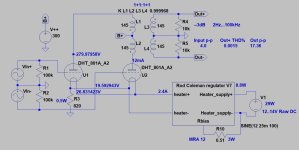
R1, R2 is symmetrical attenuator.
Thanks for all the great feedback.
@kevinkr - I have looked at the EML tubes and I think using them is a bit more than I want to tackle right now (cost, higher voltages, etc.), although one of these days I will probably use these - perhaps as a driver on new amp. For this linestage, I'd like to avoid caps if possible so I've been leaning toward filament bias and that seems like it would generate a lot of heat using the EML20B at recommended operating points.
Fortunately, I haven't had any issues with ground loops on my bass amps. The bass amps I am now using do have balanced inputs (my previous ones didn't), but I don't want to add the extra load to my preamp balanced outputs (these also use long cables). I could (and may) add a separate balanced line driver instead of using single ended outputs for this connection, but I think I will still keep this independent of the tube line stage. My woofer towers play down into the teens and I've found it a lot easier to get exceptional low-bass performance from a SS circuit.
btw - what DSP are you using? I have a Danville Signal DSP-Nexus that I've been playing with, but I'm not sure I'm ready to replace my entire front-end since this will preclude playing with new streamer/DAC/preamp builds.
@andyjevans - The 10Y is intriguing. I like the idea of trying thoriated tungsten filaments given the high praise from folks on this forum. I've seen a pretty wide range of operating points for this tube. I'd like to try filament bias, so using too high a bias voltage is going to generate a lot of heat. Have you used this tube with lower bias?
@euro21 - I just finished building a similar linestage, albeit with IDHTs (6SN7s). The downside of this topology is that all the nice 2nd harmonics are largely cancelled. It sounds pretty good, but not quite what I'm looking for. This is the main reason I want to try a new build with a DHT.
@kevinkr - I have looked at the EML tubes and I think using them is a bit more than I want to tackle right now (cost, higher voltages, etc.), although one of these days I will probably use these - perhaps as a driver on new amp. For this linestage, I'd like to avoid caps if possible so I've been leaning toward filament bias and that seems like it would generate a lot of heat using the EML20B at recommended operating points.
Fortunately, I haven't had any issues with ground loops on my bass amps. The bass amps I am now using do have balanced inputs (my previous ones didn't), but I don't want to add the extra load to my preamp balanced outputs (these also use long cables). I could (and may) add a separate balanced line driver instead of using single ended outputs for this connection, but I think I will still keep this independent of the tube line stage. My woofer towers play down into the teens and I've found it a lot easier to get exceptional low-bass performance from a SS circuit.
btw - what DSP are you using? I have a Danville Signal DSP-Nexus that I've been playing with, but I'm not sure I'm ready to replace my entire front-end since this will preclude playing with new streamer/DAC/preamp builds.
@andyjevans - The 10Y is intriguing. I like the idea of trying thoriated tungsten filaments given the high praise from folks on this forum. I've seen a pretty wide range of operating points for this tube. I'd like to try filament bias, so using too high a bias voltage is going to generate a lot of heat. Have you used this tube with lower bias?
@euro21 - I just finished building a similar linestage, albeit with IDHTs (6SN7s). The downside of this topology is that all the nice 2nd harmonics are largely cancelled. It sounds pretty good, but not quite what I'm looking for. This is the main reason I want to try a new build with a DHT.
@andyjevans - Thanks Andy. Have you built a linestage with this operating point?
Has anyone used the Mundorf M-Resist Ultra foil resistors for filament bias? These are rated at 30W with adequate heat sinking. I was thinking I'd use two in parallel.
Has anyone used the Mundorf M-Resist Ultra foil resistors for filament bias? These are rated at 30W with adequate heat sinking. I was thinking I'd use two in parallel.
If you like "nice 2nd" (dominant?) harmonics, 10Y/801 family for preamp isn't a good choice. 😛@euro21 - I just finished building a similar linestage, albeit with IDHTs (6SN7s). The downside of this topology is that all the nice 2nd harmonics are largely cancelled. It sounds pretty good, but not quite what I'm looking for. This is the main reason I want to try a new build with a DHT.
At low grid swing the output H2 is very low ... H3 even smaller.
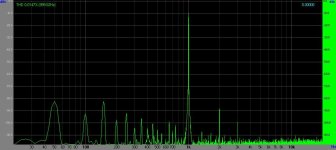
Breadboarded (hum visible) gyrator loaded 801, 1V input, about 8V output.
At large grid swing the odd harmonics growing ... the H3 can reach the H2 ... at 250Vpp output. 🤣
I've built numerous 10Y stages, some with 5 ohm cathode resistors and some with 9 ohm or 10 ohm and no doubt some in between. I used some NOS surplus stock 10W US ones that had stackable end pieces both ends so you could use multiples of them with long M3 bolts. The problem with big hot resistors is how to mount them.@andyjevans - Thanks Andy. Have you built a linestage with this operating point?
Has anyone used the Mundorf M-Resist Ultra foil resistors for filament bias? These are rated at 30W with adequate heat sinking. I was thinking I'd use two in parallel.
I use Kemet DC Link cathode bypass caps and I don't think there's too much difference between that and filament bias. Normal cathode bias is much easier to build.
I've got some fairly hefty heatsinks (200mm L x 70mm D x 30mm H) that I am planning to mount in the chassis along the sides with vents top and bottom, one heatsink for each channel. These have a thermal impedance of about 0.5C/W with minimal airflow. I'm planning to mount the active devices (that need heatsinking) for the SSHV2, RC filament supplies, and bias resistors to these. I think these should provide adequate cooling.
What I like about the Mundorf M-Resist Ultras is that they are in TO-220 packages which will make them easy to mount to the heatsinks. I think these are rebranded Powertron resistors that others have said good things about.
What I like about the Mundorf M-Resist Ultras is that they are in TO-220 packages which will make them easy to mount to the heatsinks. I think these are rebranded Powertron resistors that others have said good things about.
I'd be tempted to put the heatsinks externally on both sides as they do with Mosfet amps. That way you know you're OK. Believe me, with a 10Y in filament bias the regs and resistors get hot.
Why can't you use resistor load and direct couple to a cathode follower or solid state buffer?I haven't put 01A in there because it needs a gyrator and I prefer to use a resistor load or an OPT.
See my 801 preamp heatsinked box.
I has 250mm x 70mm x 35mm heatsink on both side.
The heatsink cooling the filament bias resistor, the gyrator board power FET, and the Rod Coleman regulator power devices.
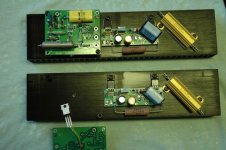
I has 250mm x 70mm x 35mm heatsink on both side.
The heatsink cooling the filament bias resistor, the gyrator board power FET, and the Rod Coleman regulator power devices.

@euro21 - looks good. How hot do your heatsinks get? I'm not looking for too much H2, just more than H3. Do you think the 26 is a better tube for a bit more H2?
@andyjevans - I could put the heatsinks on the outside if necessary, but would prefer not too. Once I get it prototyped, I'll do some measurements before I commit to the chassis design. I generally like to use pretty thick panels for my chassis which will also add some heatsinking.
@andyjevans - I could put the heatsinks on the outside if necessary, but would prefer not too. Once I get it prototyped, I'll do some measurements before I commit to the chassis design. I generally like to use pretty thick panels for my chassis which will also add some heatsinking.
I understand the points about cost, biasing will not be too different than the 26, but the filament voltage probably results in a little more heat in the regulator and resistor.Thanks for all the great feedback.
@kevinkr - I have looked at the EML tubes and I think using them is a bit more than I want to tackle right now (cost, higher voltages, etc.), although one of these days I will probably use these - perhaps as a driver on new amp. For this linestage, I'd like to avoid caps if possible so I've been leaning toward filament bias and that seems like it would generate a lot of heat using the EML20B at recommended operating points.
Fortunately, I haven't had any issues with ground loops on my bass amps. The bass amps I am now using do have balanced inputs (my previous ones didn't), but I don't want to add the extra load to my preamp balanced outputs (these also use long cables). I could (and may) add a separate balanced line driver instead of using single ended outputs for this connection, but I think I will still keep this independent of the tube line stage. My woofer towers play down into the teens and I've found it a lot easier to get exceptional low-bass performance from a SS circuit.
btw - what DSP are you using? I have a Danville Signal DSP-Nexus that I've been playing with, but I'm not sure I'm ready to replace my entire front-end since this will preclude playing with new streamer/DAC/preamp builds.
No more heat at 10Hz than 1kHz, operating point isn't changing, but the transformer cost is still a consideration if you need sub 20Hz response. I run the 20B at 24mA at 380V so a lot more dissipation than in the 26 certainly. My old line stage goes down to 20Hz, but was never in play with the subs. (They crap out just below 17Hz.)
I have the Danley SC-48 FIR which is a rebadged Linea Research ASC-48 speaker management system. These support Dante (I don't have the modules), AES and balanced analog I/0. It uses AKM ADC and DACs although I don't know exactly which ones, sounds very good. I use AES in and analog out.. Two input channels on AES, and eight analog outputs on XLR.
- Home
- Amplifiers
- Tubes / Valves
- #26 pre amp

